Brucknerhaus
Opening: Thu 5. 9. 13:00
Thu 5.9. 13:00 – 19:00
Fri 6.9. 10:00 – 17:30
Sat 7. 9. 10:00 – 17:00
Sun 8. – Mon 9. 9. 10:00 – 19:00
Use at your own risk, the title of this year’s show by undergrads in Linz Art University’s Interface Cultures program, alludes to the usual boilerplate wording of liability disclaimers. This is how manufacturers of hardware and software seek to avoid claims for damages by dissatisfied users. But regardless of what the disclaimer says, developers like these Interface Cultures students have to assess the risks their inventions and installations pose to exhibition visitors. Under certain circumstances, that could lead to a decision to dispense with completely taking advantage of all interaction options.
Nevertheless, issuing the perfunctory warning “Use at your own risk” doesn’t make this superfluous. Quite the contrary—it reminds us that experimental works of art as well do not constitute an exception to this condition of usage.
.
With works by Cesar Escudero Andaluz (XX), Davide Bevilacqua (IT), Alberto Boem (IT), Alessio Chierico (IT), Chiara Esposito (IT), Isidora Ficovic (SR), David Gann (DE), Jaak Kaevats (EE), Mihaela Kavdanska (BG), Veronika Krenn (AT) & Vesela Mihaylova (BG), Oliver Kellow (AU), Nina Mengin (AT), Ivan Petkov (BG), Marie Polakova (CZ) & Veselina Dashinova (BG/UK) & Jan Spurny (CZ), whoun a.k.a. Juan Cedenilla (ES)
Interface Cultures Faculty: Marlene Hochrieser (AT), Martin Kaltenbrunner (AT), Laurent Mignonneau (FR/AT), Michaela Ortner (AT), Georg Russegger (AT), Christa Sommerer (AT)
Brucknerhaus
WORKS
Random Readings
Cesar Escudero Andaluz (ES)
This media archeology project is based on the reinterpretation of an optical telecommunication device from 1787. It develops new interfaces (physical and graphic) by embedding current platforms such as webcams, telemonitoring systems, streaming channels or closed-circuit surveillance. The recognition system for video tracking detects the threshold color changes in five different points located on the image surface.
The information collected in these five points is decoded to an alphabetic system. Finally the letters are printed on the surface of the screen together with the previous values obtained. The final result is shown as an interactive installation that combines situations in public spaces with social control factors.
http://escuderoandaluz.com
Zuerst kommt das Fressen, dann kommt die Moral
Davide Bevilacqua (IT)

Vegetarians, optimized production, low-calories drinks, bio-fast-naturally colored dishes. We are surrounded by different foods, symbols of cultures and fashions. Food has always played a central role in social gatherings, as a cultural sign and a collective ritual. Each event has indeed its own type of refreshment: wedding breakfasts, buffets, brunches. This buffet provides the suitable refreshments for the Interface Cultures’ exhibition at the Ars Electronica Festival. The audience will enjoy a buffet made of experimental dishes and drinks. There will be original and collected recipes, some of them are close to the molecular kitchen, others to the DIY community. The selection follows a research lead by curiosity, lust for experimenting with food, discovering how ingredients react with each other and trying out new tastes and forms for usual dishes.
Sculpton
Alberto Boem (IT)
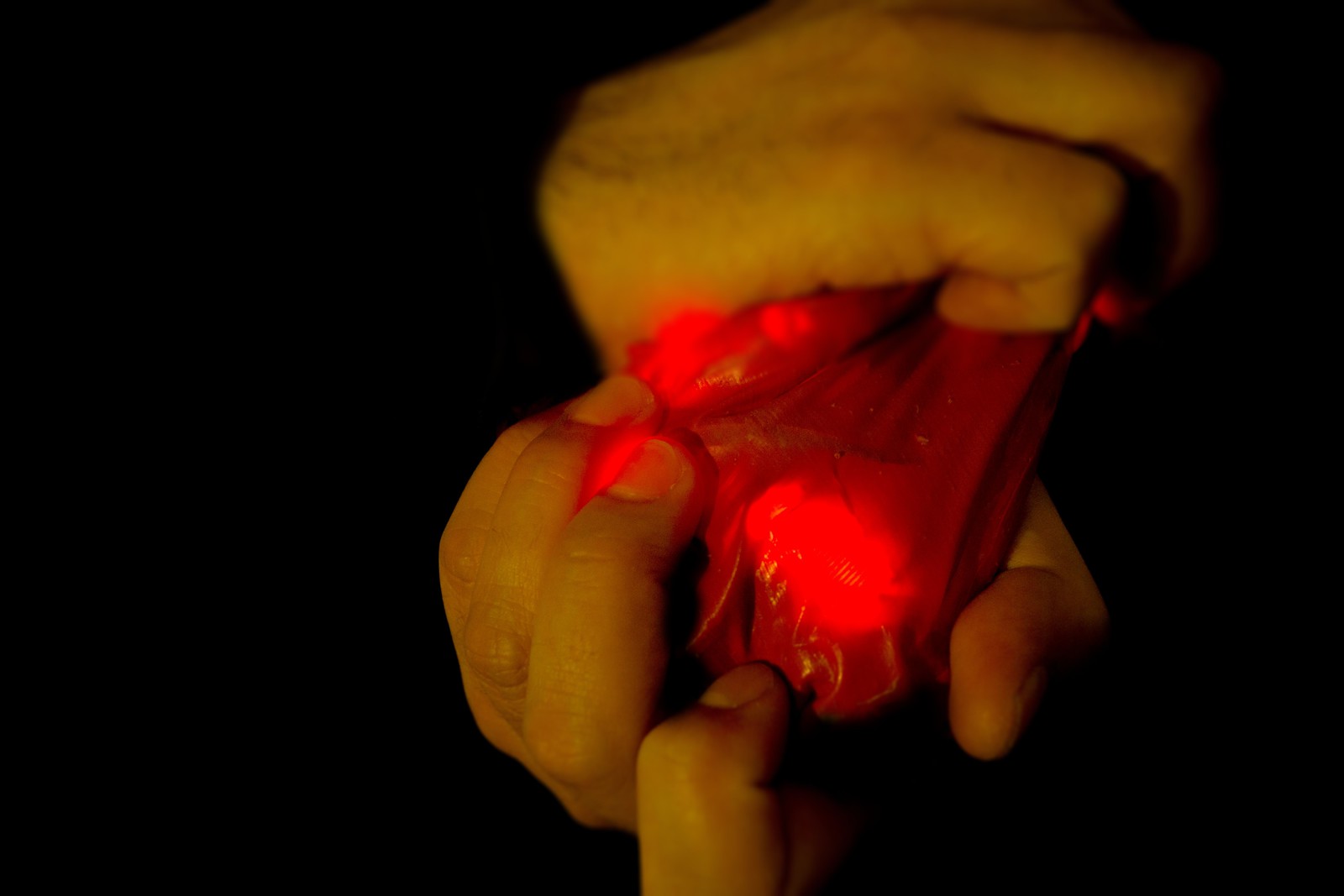
Sculpton is a malleable sonic object that uses the metaphor of sound sculpting for connecting physical information in digital audio. By manipulating the object the user can literally sculpt the sound through a real-time sound synthesis that reverberates the object structure. Sculpton is an attempt to develop a new kind of digital musical instruments that combines multidimensional control, tangible and malleable characteristics with organic handling. This quality has an intimate relation with the sound production: the user shapes the sound by molding the object. Beyond the idea of control, Sculpton represents a sonic object that promotes physical effort and engagement with musical and non-musical characteristics. Sculpton is an interface for musicians and performers strongly based on the idea of exploration and improvisation, a tool for composing electronic music on stage.
Arnulf Rainer for digital performers, concert version
Alessio Chierico (IT)
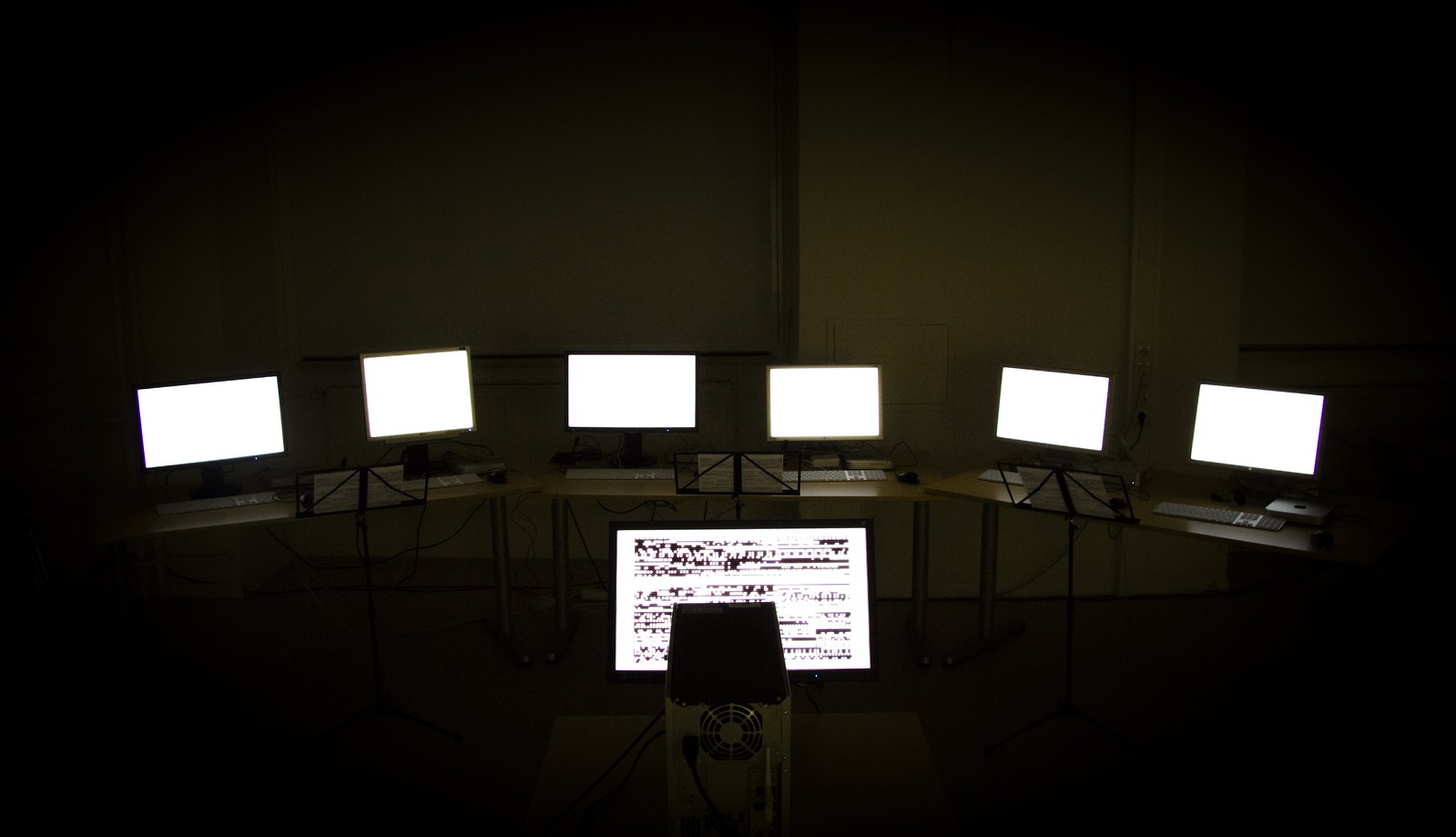
Arnulf Rainer for digital performers is a reenactment from the composition Arnulf Rainer by Peter Kubelka, which creates its visual aesthetic from the essence of the cinematic image: light and its variations. Like digital systems, it comprises solely a binary alternation of light and no light. The storyboard is a composition that appears like a digital sequence. Arnulf Rainer for digital performers is based on a software that analyzes a remade composition of Peter Kubelka in real time, in order to extract the status (black or white) for each frame. Afterwards the main computer, metaphorically seen as the director, sends the status to a device ensemble meant as players, in order to perform the composition. Their interpretation becomes the real performance, which underlines the visual property of each performer. Arnulf Rainer for digital performers is a concert played by visual media that propose a contemporary aesthetic of the original score.
The dream of flying
Chiara Esposito (IT)
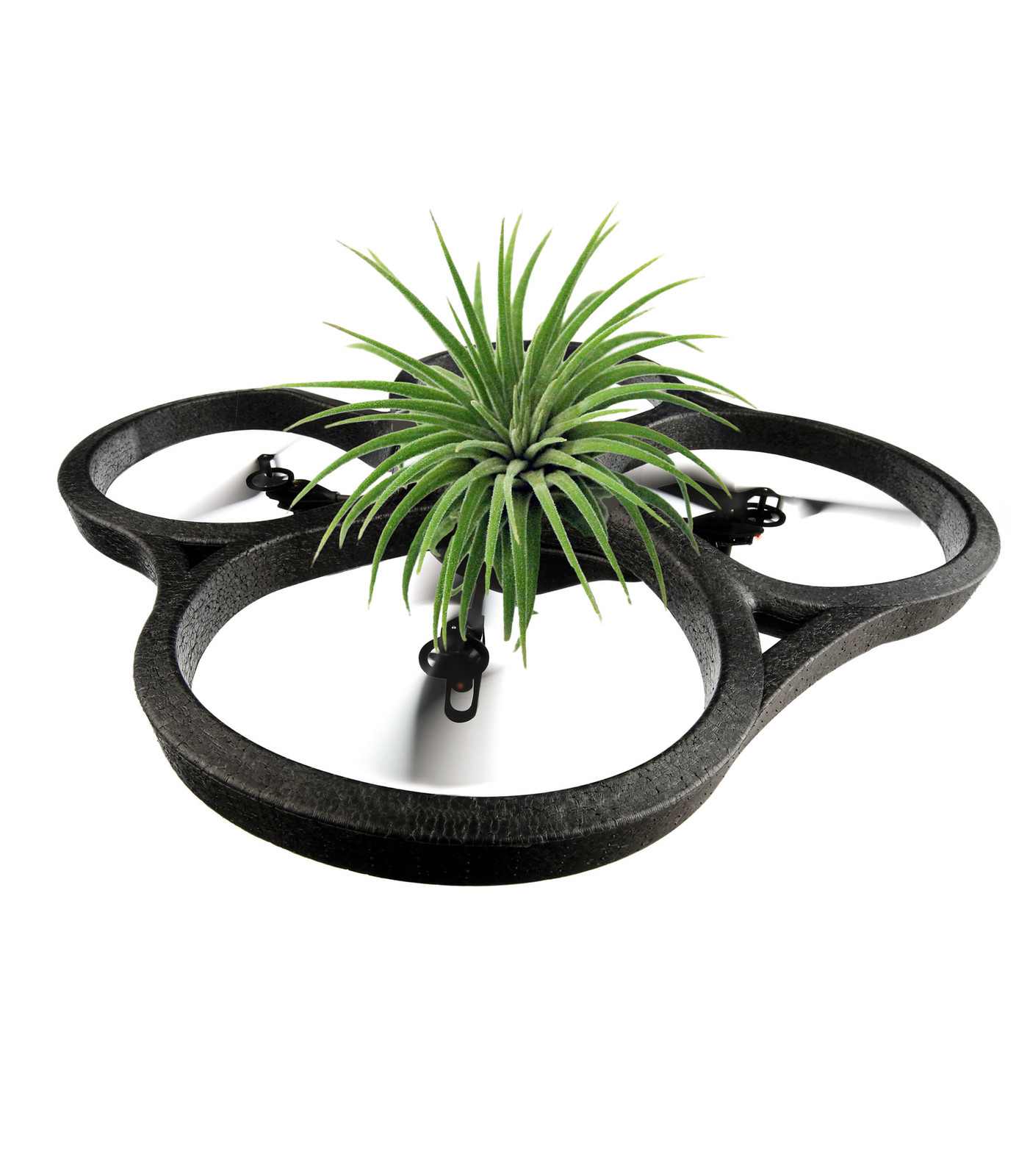
Sometimes a plant dreams of flying. Usually we associate a plant with the ground and immobility. Movement is a feature of animals. Movements in plants are usually imperceptible and associated with growth or following the sun. Plants that are capable of rapid movements look like strange chimeras. Speed is not a feature of plants. But some plants indeed have an affinity with the air and the flight: some have no roots and get their nutrients from the air, others use the wind to let their seeds move quicker, or need the action of insects or birds to reproduce. Dandelions let their seeds fly gently, other plants spit them out like rockets. Every plant reacts to the environment in a different way. In the artwork *The dream of flying*, an interface enables a plant to control a body extension: a small flying device. The interface measures the electrical activity of the plant and uses the gathered data to control the flight. The plant works here as an actor and a sensor, creating an open system in which visitors and the environment are actively participating to influence the pattern of the flying device.
Think Pink
Isidora Ficovic (SR)

This interactive video installation uses the qualitative research method of taking interviews in the streets of Linz. The public was asked the question ‘Which tool would you use to destroy a desktop?’ The most common answer was “the hammer”. The public decided the hammer should become the non-verbal communication tool. By hitting with the hammer the visitor of the exhibition triggers videos that are showing the interviews. Embedded sensors randomly open different videos, but only one is the key to the *Think Pink* when the monitor changes to become a pink color.
Memories of the Future
David Gann (DE)
The genome is the basic level of memory and contains the building plan for us as human beings. As we have begun to understand our genetic code and are more and more able to change it, it is time to think about and discuss the potential impact on future generations. In this work multiple users can explore an interactive audio-visual map of the human genome on a touchscreen. About 28,000 genes are positioned on a ring that represents the genome. The brightness stands for the expression level (how much gene product is produced) of a gene and the lines indicate the interaction between those. The genes are sonic grains on a long audio sample that contains many aspects of our culture and civilization. The user can associate his/her own audible memories with the sonification and gets a better spatial and relational understanding of the visualization. The user-interactions are recorded and the resulting data and musical compositions are published.
Science-Interactive.com, SymbioticCube.com
Street-Scape
Jaak Kaevats (EE)
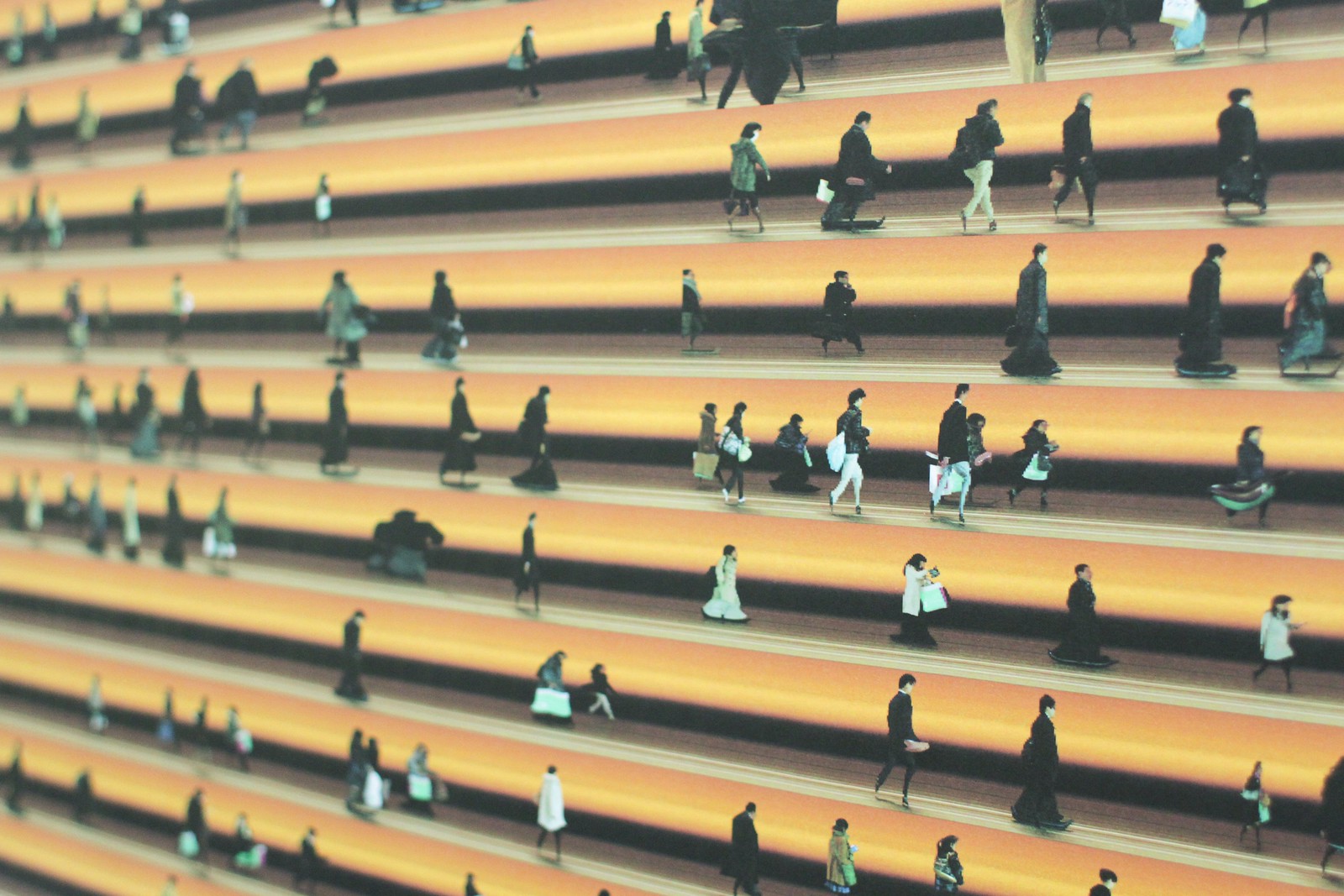
Street-Scape is a contextual visualization of an urban environment. The walking direction of people in the street is plotted in one direction on the 5-minute timeline to make their relative distances between each other more apparent. The visualizations are rendered in a way that produces people walking 5km/h (average walking speed) with original proportions, everyone moving faster becomes thinner and everyone slower is mapped respectively wider. Street-Scape renders the captured people anonymous while revealing their demographic qualities such as their approximate age and gender. Thus, presenting the relative amount of children, grown-ups, older people, bikers, etc. in a particular location during the visualized time.
http://kaevats.org/street-scape
4th Skin
Mihaela Kavdanska (BG)

The 4th Skin project visualizes what we see, touch or reflect. It is the “skin” created by our whole body & mind experience and our relations with the world around. This interactive audio-visual piece has a strong performative and site-specific component. The relations between the performer and the surroundings result in the form of ephemeral multimedia garment. The video content is created live according to the performers’ explorations with mobile filming devices: their presence in a given space, bodies, movements, actions, textures, these all become part of the dynamic garment. By acting in one way or another, the performer changes the garment’s content. The captured video footage is projected on the performer’s body using custom-developed video tracking & video mapping solution. The 4th Skin is a comment on the subjects of ephemerality, transience and impermanence. It reflects the sense-based exchange between oneself and the world around.
Programming by Cristian Iordache
Sound by Sorin Paun aka Randomform
Performers: Dolma Jover Agullo & Luis Gonzaga Hoyos
A project co-produced by KOTKI visuals
Acidable
Veronika Krenn (AT), Vesela Mihaylova (BG)
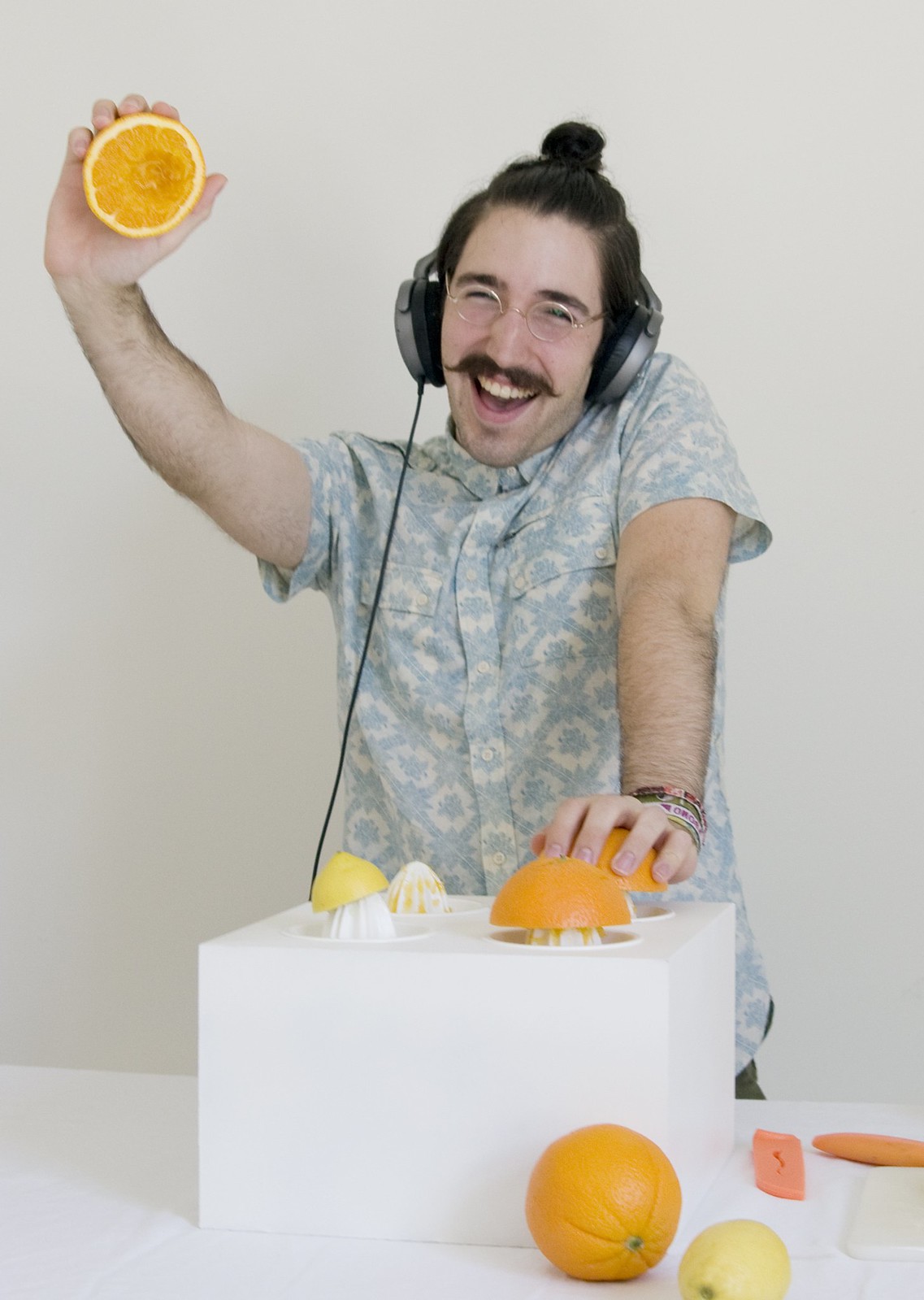
The Acidable is an interactive turntable and orange squeezer at the same time. Based on the familiar movement of manually squeezing a piece of citrus fruit, the interaction with the Acidable reaches a new level of playful experience. Depending on the pH value of the freshly pressed citrus juice, the machine creates a rhythm, and the music is modified by the motion of squeezing the fruit. This work is an interactive experiment to bring back food production into our daily life. The visitor is invited to try out the new playful device and enjoy the freshly pressed orange juice.
Digital HourGlass
Oliver Kellow (AU)
The Digital HourGlass is an abstracted hourglass form set in granite and extending an antenna towards the sky. Like sands running to the lower bulb, the Digital HourGlass will change states when the upper bulb expires. The viewer may touch the frame of the hourglass, changing the power configuration and increasing the stress on the bulb. Symbolically, it represents the consciously marked passage of time and energy, providing no reference point to gauge the amount of time or energy remaining or previously spent. The only known value is that as a physical and familiar device it must degrade and expire, the moment of transition is pure serendipity, unpredictable to both the author and the viewer. This consciousness of time, energy and decay is accentuated by the physicality of the high-consumption, antiquated Edison bulbs used. It is a simple reminder that although time and energy is always flowing, we have the opportunity and the capability to use it or alter its path.
Suppenbrunzer
Nina Mengin (AT)

The communicative and ritual aspects of eating undergo continuous changes. Fast food and convenience food have radically changed our eating behavior. One of the consequences is that individual snacks replace ritual meals within a family. Even if we eat high quality foods, we still lack the time for a proper meal. The installation quotes a traditional Austrian dining table, but it is squeezed in between walls and can only be used by one person at a time. Snacks are available next to it, and they have to be placed on the table to activate the Suppenbrunzer and start the interaction. The whole procedure only takes a few seconds, in this way the Suppenbrunzer adapts to the prevalent food culture.
A Day In A Life
Ivan Petkov (BG)
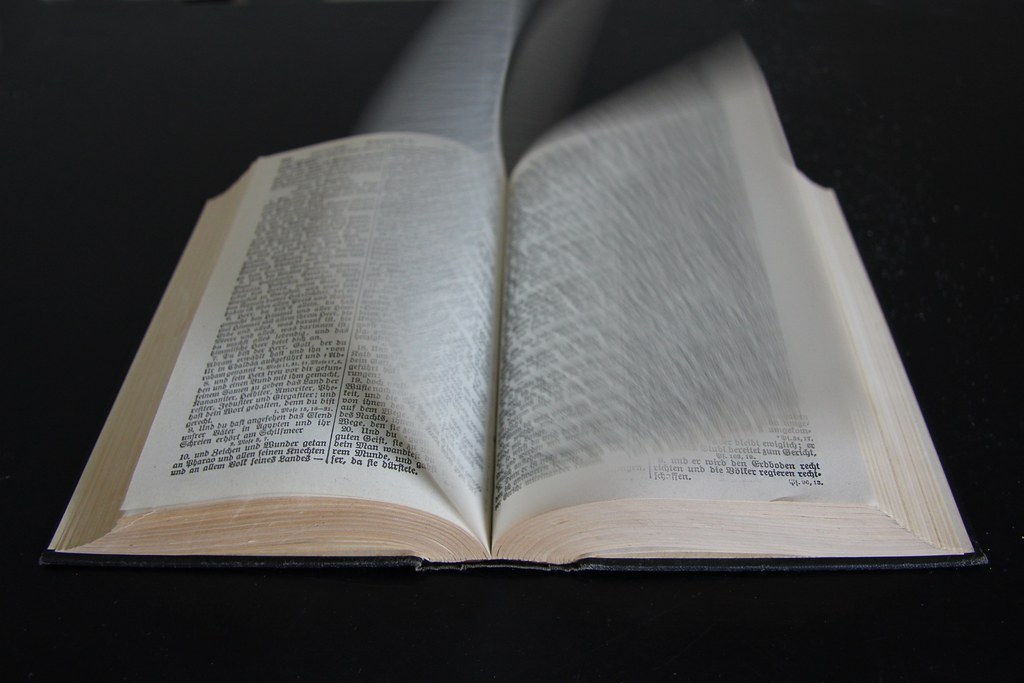
”Suffering makes you live time in detail, moment after moment.“ E.M. Cioran, The New Gods.
Starting at sunrise, the pages of an empty book are turned by an airflow. At midday, the amount of the pages that have been turned roughly equals the ones that are still left. At sunset, the end of the book is reached. An unexpected usage of a book takes place in this installation. It is blank, but can still be read. In an intuitive way, without the torturous precision of the signs and by the invisible power of the wind. It reveals the time passed since the morning and the time left till dusk. It is reminiscent of a bygone era in which the active life was restricted to the daytime hours.
Micro Pets
Marie Polakova (CZ), Veselina Dashinova (BG/UK), Jan Spurny
Have you ever thought that microscopic organisms could be something more then a scientific specimen or feared disease? Something you could care for and even grow to love? The Micro Pets project looks into the unthinkable, considering microbes of infinitesimal size as endearing and captivating creatures–as playful companions with personality and charm. The artists have addressed the difficult task of observing and understanding the natural behaviors of water microorganisms Building on their practical and conceptual research, their aim is to design suitable nano toys for such creatures, together with ‘Micro Pet Lifestyle Accessories’ The toys and accessories will be specially suited to the particular behavior and needs of each microorganism group. So far one can see a design of a toy and a digital simulation of the interaction between the Micro Pets and their toys. The next aim of the artists is to develop the design further and subsequently produce the toys.
Created at Interface Cultures Lab with support from the Ars Electronica Bio Lab.
240313:Bit-Poems
by whoun a.k.a. Juan Cedenilla (ES)

240313:Bit-Poems is a collection of several poems and a possible visualization of each of them. These bit-poems are created by rules of poetry applied to bits. The contemporary world demands a different way of perceiving the digital aesthetic. For this reason, this project aims to transfer a concept of the non-digital world to the digital world and observe the result. The starting point is something created by humans: poetry. One of the main goals of poetry is to communicate. The poetry form follows a series of rules and conditions. Communication, rules and conditions are the settings of a protocol in the digital world. Visualizing this protocol can create a better non-digital understanding of it. This allows us to explore and discover the result of the translation of such a concept.
Brucknerhaus
Opening: Thu 5. 9. 13:00
Thu 5.9. 13:00 – 19:00
Fri 6.9. 10:00 – 17:30
Sat 7. 9. 10:00 – 17:00
Sun 8. – Mon 9. 9. 10:00 – 19:00

